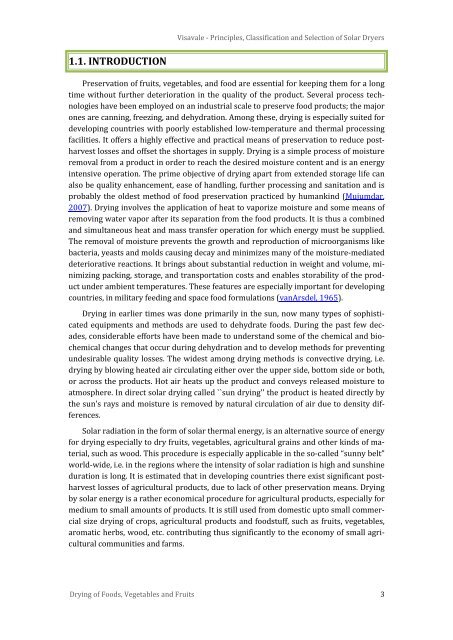Solar Drying: Fundamentals,Applications and Innovations - National ...
Solar Drying: Fundamentals,Applications and Innovations - National ...
Solar Drying: Fundamentals,Applications and Innovations - National ...
You also want an ePaper? Increase the reach of your titles
YUMPU automatically turns print PDFs into web optimized ePapers that Google loves.
Visavale - Principles, Classification <strong>and</strong> Selection of <strong>Solar</strong> Dryers<br />
1.1. INTRODUCTION<br />
Preservation of fruits, vegetables, <strong>and</strong> food are essential for keeping them for a long<br />
time without further deterioration in the quality of the product. Several process technologies<br />
have been employed on an industrial scale to preserve food products; the major<br />
ones are canning, freezing, <strong>and</strong> dehydration. Among these, drying is especially suited for<br />
developing countries with poorly established low-temperature <strong>and</strong> thermal processing<br />
facilities. It offers a highly effective <strong>and</strong> practical means of preservation to reduce postharvest<br />
losses <strong>and</strong> offset the shortages in supply. <strong>Drying</strong> is a simple process of moisture<br />
removal from a product in order to reach the desired moisture content <strong>and</strong> is an energy<br />
intensive operation. The prime objective of drying apart from extended storage life can<br />
also be quality enhancement, ease of h<strong>and</strong>ling, further processing <strong>and</strong> sanitation <strong>and</strong> is<br />
probably the oldest method of food preservation practiced by humankind (Mujumdar,<br />
2007). <strong>Drying</strong> involves the application of heat to vaporize moisture <strong>and</strong> some means of<br />
removing water vapor after its separation from the food products. It is thus a combined<br />
<strong>and</strong> simultaneous heat <strong>and</strong> mass transfer operation for which energy must be supplied.<br />
The removal of moisture prevents the growth <strong>and</strong> reproduction of microorganisms like<br />
bacteria, yeasts <strong>and</strong> molds causing decay <strong>and</strong> minimizes many of the moisture-mediated<br />
deteriorative reactions. It brings about substantial reduction in weight <strong>and</strong> volume, minimizing<br />
packing, storage, <strong>and</strong> transportation costs <strong>and</strong> enables storability of the product<br />
under ambient temperatures. These features are especially important for developing<br />
countries, in military feeding <strong>and</strong> space food formulations (vanArsdel, 1965).<br />
<strong>Drying</strong> in earlier times was done primarily in the sun, now many types of sophisticated<br />
equipments <strong>and</strong> methods are used to dehydrate foods. During the past few decades,<br />
considerable efforts have been made to underst<strong>and</strong> some of the chemical <strong>and</strong> biochemical<br />
changes that occur during dehydration <strong>and</strong> to develop methods for preventing<br />
undesirable quality losses. The widest among drying methods is convective drying, i.e.<br />
drying by blowing heated air circulating either over the upper side, bottom side or both,<br />
or across the products. Hot air heats up the product <strong>and</strong> conveys released moisture to<br />
atmosphere. In direct solar drying called ``sun drying'' the product is heated directly by<br />
the sun's rays <strong>and</strong> moisture is removed by natural circulation of air due to density differences.<br />
<strong>Solar</strong> radiation in the form of solar thermal energy, is an alternative source of energy<br />
for drying especially to dry fruits, vegetables, agricultural grains <strong>and</strong> other kinds of material,<br />
such as wood. This procedure is especially applicable in the so-called “sunny belt”<br />
world-wide, i.e. in the regions where the intensity of solar radiation is high <strong>and</strong> sunshine<br />
duration is long. It is estimated that in developing countries there exist significant postharvest<br />
losses of agricultural products, due to lack of other preservation means. <strong>Drying</strong><br />
by solar energy is a rather economical procedure for agricultural products, especially for<br />
medium to small amounts of products. It is still used from domestic upto small commercial<br />
size drying of crops, agricultural products <strong>and</strong> foodstuff, such as fruits, vegetables,<br />
aromatic herbs, wood, etc. contributing thus significantly to the economy of small agricultural<br />
communities <strong>and</strong> farms.<br />
<strong>Drying</strong> of Foods, Vegetables <strong>and</strong> Fruits 3

















